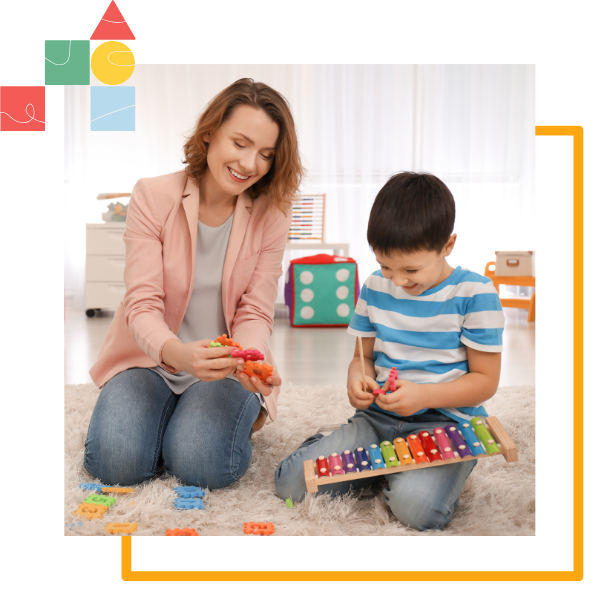Key Highlights
- Sensory Processing Disorder (SPD) and Autism Spectrum Disorder (ASD) are distinct conditions that require different approaches to treatment
- SPD is a condition in which the brain has difficulty processing information from the senses, resulting in over- or under-sensitivity to sensory input
- ASD is a neurodevelopmental disorder that affects social interaction, communication, and behavior, with sensory issues being just one aspect of the condition
- Treatment for SPD may involve occupational therapy and sensory integration therapy, while treatment for ASD may involve behavioral therapy and speech therapy
- SPD and ASD can co-occur, with up to 70% of children with ASD also having sensory processing issues
- The causes of SPD and ASD are not fully understood, but genetic and environmental factors are thought to play a role
Introduction
Understanding Sensory Processing Disorder (SPD) and Autism Spectrum Disorder (ASD) is essential for individuals, families, and healthcare professionals involved in their care. While these two conditions share some similarities, it is crucial to recognize that they are distinct and require different approaches to treatment. SPD is a condition in which the brain has difficulty processing information from the senses, leading to over- or under-sensitivity to sensory input. ASD, on the other hand, is a neurodevelopmental disorder that affects social interaction, communication, and behavior. While sensory issues can be a part of ASD, they are just one aspect of the condition.
In this blog, we will explore the basics of Sensory Processing Disorder (SPD) and Autism Spectrum Disorder (ASD), including their definitions, symptoms, diagnostic procedures, intervention strategies, and the role of Applied Behavior Analysis (ABA) in addressing SPD. We will also discuss the impact of these conditions on daily life, the importance of early intervention, and available resources for families and communities. By understanding these conditions, we can provide better support and care for individuals with SPD and ASD.
Exploring the Basics of Sensory Processing Disorder (SPD)
Sensory Processing Disorder (SPD) is a condition in which the brain has difficulty processing information from the senses. This means that individuals with SPD may have over- or under-sensitivity to sensory input, such as touch, sound, taste, smell, and sight. These sensory processing difficulties can manifest in various ways and can significantly impact daily life. Sensory integration, the ability to organize and interpret sensory information, plays a crucial role in how individuals with SPD experience and respond to the world around them.
Defining SPD and Its Significance in Development
Sensory Processing Disorder (SPD) is a condition that typically presents in early childhood and can affect individuals throughout their lives. It is estimated that approximately 1 in 20 children may have SPD. The significance of SPD lies in its potential impact on a child's development and daily functioning. If left untreated, SPD can affect various areas of development, including motor skills, social skills, emotional regulation, and learning abilities. It is crucial for parents, caregivers, and healthcare professionals to recognize the signs and symptoms of SPD in order to provide appropriate support and intervention to help individuals with SPD thrive.
Identifying the Symptoms: When to Seek an SPD Test
Identifying the symptoms of Sensory Processing Disorder (SPD) is crucial for early intervention and appropriate treatment. While the specific symptoms can vary from person to person, some common signs of SPD include over- or under-sensitivity to sensory input, difficulty with coordination and balance, dislike of certain textures or sounds, and avoidance of certain activities or environments. If you suspect that you or your child may have SPD, it is important to seek an SPD test. Healthcare professionals can conduct a comprehensive evaluation, including a sensory profile assessment, to determine if an individual meets the diagnostic criteria for SPD. Early detection and diagnosis can lead to early intervention and better outcomes for individuals with SPD.
Autism Spectrum Disorder (ASD) Overview
Autism Spectrum Disorder (ASD) is a neurodevelopmental disorder that affects social interaction, communication, and behavior. It is characterized by a range of symptoms and varying levels of severity. Individuals with ASD may have difficulties with social cues, language and communication skills, and exhibit repetitive behaviors or intense interests. While sensory issues can be a part of ASD, they are just one aspect of the condition. Understanding the overall impact of ASD on individuals is crucial for providing appropriate support and intervention to help them thrive.
Understanding ASD and Its Impact on Individuals
Autism Spectrum Disorder (ASD) can have a significant impact on individuals' social interaction, communication, and overall quality of life. Difficulties with social interaction can make it challenging for individuals with ASD to form relationships, understand social cues, and participate in group activities. Communication skills may be delayed or atypical, making it difficult for individuals to express their needs and emotions effectively. These challenges can lead to feelings of isolation, frustration, and anxiety. It is essential for individuals with ASD to receive appropriate support and intervention to improve their social and communication skills and enhance their overall quality of life.
The Intersection of ASD and Sensory Processing Issues
Sensory processing issues often co-occur with Autism Spectrum Disorder (ASD). Up to 70% of children with ASD also have sensory processing issues. These sensory challenges can manifest as over- or under-sensitivity to sensory input, such as touch, sound, taste, smell, and sight. Sensory sensitivities can further impact individuals with ASD's ability to function and engage in daily activities. Understanding the intersection between ASD and sensory processing issues is crucial for providing targeted interventions and supports to address the unique needs of individuals with ASD.
The Role of Applied Behavior Analysis (ABA) in Addressing SPD
Applied Behavior Analysis (ABA) is a therapeutic approach that has shown effectiveness in addressing Sensory Processing Disorder (SPD). ABA focuses on understanding and modifying behavior using evidence-based techniques. In the context of SPD, ABA techniques can be used to support sensory integration, which is the ability to process sensory input effectively. ABA interventions may involve structured activities, positive reinforcement, and behavior modification strategies to help individuals with SPD improve their sensory processing abilities and enhance their overall functioning. ABA can be implemented by trained professionals, such as behavior analysts or occupational therapists, who specialize in sensory integration therapy.
How ABA Techniques Support Sensory Integration
Applied Behavior Analysis (ABA) techniques support sensory integration by providing structured interventions that help individuals with Sensory Processing Disorder (SPD) better process sensory input. ABA therapists or occupational therapists often use specific activities and strategies to expose individuals to various sensory stimuli in a controlled and therapeutic manner. These activities may include sensory play, movement exercises, and occupational therapy techniques that target specific sensory systems, such as touch, sound, or proprioception. Through consistent practice and reinforcement, individuals with SPD can improve their sensory processing abilities and develop strategies to cope with sensory challenges in their daily lives.
ABA's Effectiveness for Children with SPD and Autism
Applied Behavior Analysis (ABA) has shown effectiveness in improving outcomes for children with both Sensory Processing Disorder (SPD) and Autism Spectrum Disorder (ASD). Early intervention using ABA techniques can help children with SPD and ASD develop appropriate social and communication skills, reduce repetitive behaviors, and enhance their overall functioning. ABA interventions focus on teaching new skills, reducing challenging behaviors, and providing support for daily living activities. By targeting the unique needs of children with SPD and ASD, ABA can make a significant difference in their development and quality of life.
Diagnostic Procedures for SPD and ASD
Accurate diagnosis of Sensory Processing Disorder (SPD) and Autism Spectrum Disorder (ASD) is crucial for providing appropriate support and intervention. Diagnostic procedures for SPD and ASD typically involve a comprehensive evaluation conducted by healthcare professionals who specialize in these conditions. The evaluation may include interviews with parents or caregivers, direct observation of the individual's behavior, and standardized assessments. Diagnostic criteria, such as those outlined in the Diagnostic and Statistical Manual of Mental Disorders (DSM-5), are used to determine if an individual meets the criteria for SPD or ASD. A thorough and accurate diagnosis is essential for tailoring interventions to the individual's specific needs.
Steps in the SPD Testing Process
The testing process for Sensory Processing Disorder (SPD) typically involves a comprehensive assessment of an individual's sensory processing abilities. This assessment may include the use of standardized measures, such as the Sensory Processing Measure, to evaluate an individual's sensory processing patterns. The assessment may also involve interviews with parents or caregivers to gather information about the individual's sensory experiences and behaviors. Through this process, healthcare professionals can gain a better understanding of the individual's sensory processing difficulties and develop appropriate interventions to address their specific needs.
Comprehensive Evaluation for Autism Spectrum Disorder
The comprehensive evaluation for Autism Spectrum Disorder (ASD) involves a thorough assessment of an individual's behavior, communication skills, and social interactions. Healthcare professionals use standardized assessments and diagnostic criteria outlined in the Diagnostic and Statistical Manual of Mental Disorders (DSM-5) to determine if an individual meets the criteria for ASD. The evaluation may also include interviews with parents or caregivers, observation of the individual's behavior in different settings, and consideration of environmental factors that may contribute to the development of ASD. A comprehensive evaluation is essential for accurate diagnosis and the development of appropriate interventions for individuals with ASD.
Intervention Strategies for SPD
Intervention strategies for Sensory Processing Disorder (SPD) focus on helping individuals better process sensory input and improve their overall functioning. Sensory integration therapy, often conducted by occupational therapists, is a common intervention for SPD. This therapy involves engaging individuals in activities that provide sensory stimulation in a structured and therapeutic manner. The goal is to help individuals gradually become more comfortable with sensory experiences and develop strategies to cope with sensory challenges. Interventions for SPD are tailored to the individual's specific needs and may include a combination of sensory integration therapy, occupational therapy, and other interventions to address their unique sensory processing difficulties.
Sensory Integration Therapy Explained
Sensory integration therapy is a therapeutic approach used to address Sensory Processing Disorder (SPD). This therapy aims to help individuals with sensory processing difficulties improve their ability to process and respond to sensory input effectively. Occupational therapists often use sensory integration therapy techniques to engage individuals in activities that provide sensory stimulation in a controlled and therapeutic manner. These activities may involve touch, movement, or other sensory experiences that target specific sensory systems. The goal of sensory integration therapy is to help individuals develop improved sensory processing skills, enhance their overall functioning, and improve their quality of life.
Tailoring Interventions to Individual Needs
Interventions for Sensory Processing Disorder (SPD) are tailored to each individual's specific needs. A comprehensive evaluation, including an assessment of the individual's sensory profile, helps healthcare professionals identify the areas of difficulty and develop targeted interventions. The interventions may involve a combination of sensory integration therapy, occupational therapy techniques, and other evidence-based approaches. The goal is to provide individualized treatment that addresses the unique sensory processing challenges faced by each individual with SPD. By tailoring interventions to their specific needs, individuals with SPD can make significant progress in improving their sensory processing abilities and overall functioning.
ABA Therapeutic Approaches for ASD
Applied Behavior Analysis (ABA) is a widely used therapeutic approach for addressing Autism Spectrum Disorder (ASD). ABA focuses on understanding and modifying behavior using evidence-based techniques. ABA therapists, often behavior analysts, use behavior analysis principles to target specific behaviors, such as social skills, communication, and daily living skills. The goal of ABA therapy for ASD is to help individuals improve their adaptive behavior, reduce challenging behaviors, and enhance their overall quality of life. ABA approaches can be customized to meet the specific needs of individuals with ASD and are often implemented through structured and individualized programs.
Key ABA Techniques for Autism Management
Applied Behavior Analysis (ABA) techniques play a crucial role in managing the symptoms of Autism Spectrum Disorder (ASD) and promoting positive behaviors. Some key ABA techniques used in autism management include teaching social skills, improving communication skills, and using behavior modification strategies. ABA therapists focus on breaking down complex skills into smaller, manageable steps, providing systematic and consistent reinforcement, and using visual supports to enhance understanding. By targeting specific behaviors and providing appropriate support, ABA techniques can help individuals with ASD develop essential skills and reduce challenging behaviors, leading to improved social interactions, communication, and overall functioning.
Customizing ABA Programs for Optimal Outcomes
One of the strengths of Applied Behavior Analysis (ABA) is its ability to customize programs to meet the specific needs of individuals with Autism Spectrum Disorder (ASD). ABA programs are designed to be individualized, taking into account the unique characteristics, strengths, and challenges of each individual. ABA therapists work closely with individuals with ASD and their families to develop goals and strategies that align with their specific needs and desired outcomes. By customizing ABA programs, therapists can maximize the effectiveness of intervention, promote optimal outcomes, and improve the overall quality of life for individuals with ASD.
Navigating Challenges: SPD, ASD, and Education
Sensory Processing Disorder (SPD) and Autism Spectrum Disorder (ASD) can present unique challenges in educational settings. It is crucial for educators to understand the sensory processing challenges faced by students with SPD and ASD and implement appropriate strategies to support their learning and participation. This may involve creating sensory-friendly environments, providing sensory accommodations, and using educational strategies that promote inclusive education. By recognizing and addressing the specific needs of students with SPD and ASD, educators can create a supportive and inclusive learning environment that maximizes their potential for academic and social success.
Strategies for Educators Supporting Neurodiverse Students
Educators play a vital role in supporting the learning and development of neurodiverse students, including those with Sensory Processing Disorder (SPD) and Autism Spectrum Disorder (ASD). Some strategies that educators can use to support these students include understanding and accommodating sensory processing differences, providing sensory breaks or sensory tools, and incorporating sensory activities into the classroom. It is also essential for educators to promote inclusive practices, provide clear and consistent expectations, and offer appropriate educational support tailored to the individual needs of each student. By implementing these strategies, educators can create an inclusive learning environment that supports the academic and social growth of neurodiverse students.
Creating Inclusive Classrooms for Sensory Sensitive Individuals
Creating inclusive classrooms that support sensory-sensitive individuals is crucial for their academic and social success. Educators can create sensory-friendly environments by reducing visual and auditory distractions, providing comfortable seating options, and adjusting lighting levels. Offering sensory accommodations, such as noise-cancelling headphones or fidget tools, can also help individuals with Sensory Processing Disorder (SPD) and Autism Spectrum Disorder (ASD) manage sensory challenges in the classroom. Additionally, promoting understanding and acceptance among peers through education and fostering a culture of inclusivity can create a supportive and welcoming classroom environment for all students.
Family Support and Community Resources
Family support and access to community resources are essential for individuals and families affected by Sensory Processing Disorder (SPD) and Autism Spectrum Disorder (ASD). Families can find support through parent support groups, online communities, and educational resources that provide information and strategies managing the challenges associated with these conditions. Healthcare professionals, such as pediatricians, occupational therapists, and behavior analysts, can offer guidance, assessments, and interventions tailored to the individual's needs. By connecting with supportive networks and accessing appropriate resources, families can navigate the journey of SPD and ASD more effectively.
Building a Support Network for Families Affected by SPD and ASD
Building a support network is essential for families affected by Sensory Processing Disorder (SPD) and Autism Spectrum Disorder (ASD). A support network can provide emotional support, share experiences, and offer practical advice and strategies for managing the challenges associated with these conditions. Parents can connect with other families through parent support groups, online forums, and local community organizations focused on SPD and ASD. Engaging with the community and participating in educational events or workshops can also provide valuable information and resources. By building a support network, families can find a sense of belonging, understanding, and shared experiences that can make the journey of SPD and ASD more manageable.
Accessing Services and Supports in Texas
Accessing services and support is crucial for individuals and families affected by Sensory Processing Disorder (SPD) and Autism Spectrum Disorder (ASD) in Texas. Texas offers a range of resources and healthcare professionals specializing in the diagnosis and treatment of SPD and ASD. Families can seek support from healthcare professionals such as pediatricians, occupational therapists, and behavior analysts who can provide assessments, interventions, and guidance tailored to the individual's needs. Additionally, community organizations, parent support groups, and online platforms can provide valuable information and connections to resources in the local area. By accessing these services and supports, individuals and families in Texas can receive the necessary assistance to navigate the challenges of SPD and ASD effectively.
The Importance of Early Intervention
Early intervention is crucial for individuals with Sensory Processing Disorder (SPD) and Autism Spectrum Disorder (ASD). Detecting and addressing these conditions early can significantly impact a child's development and long-term outcomes. Early intervention allows for the implementation of targeted interventions, therapies, and supports that can help individuals with SPD and ASD develop essential skills and overcome challenges. By identifying developmental milestones, recognizing early signs of SPD and ASD, and seeking appropriate evaluations and interventions, families can provide the necessary support and intervention during the critical early years of a child's development.
Benefits of Early Detection and Treatment for SPD and ASD
Early detection and treatment of Sensory Processing Disorder (SPD) and Autism Spectrum Disorder (ASD) can make a significant difference in a child's development and overall quality of life. Early intervention allows for the implementation of targeted therapies and supports that can help children with SPD and ASD develop essential skills, overcome challenges, and reach their full potential. By addressing the specific needs of the individual early on, families can provide the necessary support and intervention during the critical early childhood years when the brain is most adaptable. Early detection and treatment can lead to improved outcomes, increased independence, and enhanced overall quality of life for individuals with SPD and ASD.
Navigating the Journey: From Diagnosis to Intervention
Navigating the journey from diagnosis to intervention for Sensory Processing Disorder (SPD) and Autism Spectrum Disorder (ASD) can be overwhelming for families. It involves multiple steps, including the diagnostic process, understanding the individual's specific needs, and finding appropriate intervention strategies. Families should seek evaluations from healthcare professionals who specialize in SPD and ASD. Once a diagnosis is obtained, families can work closely with healthcare professionals to develop tailored intervention strategies, such as sensory integration therapy, occupational therapy, and ABA techniques. The journey to intervention requires patience, support, and access to resources and services. By staying informed, seeking guidance, and connecting with supportive networks, families can navigate the journey of SPD and ASD more effectively.
Conclusion
In conclusion, understanding Sensory Processing Disorder (SPD) and Autism Spectrum Disorder (ASD) is crucial for early intervention and effective management. From recognizing symptoms to exploring intervention strategies like Applied Behavior Analysis (ABA), this comprehensive guide aims to shed light on navigating challenges faced by individuals with SPD and ASD. Educators, families, and communities play vital roles in supporting neurodiverse individuals. Early detection, tailored interventions, and a supportive environment are key in improving outcomes for those affected by SPD and ASD. By accessing services, building a network of support, and staying informed about new developments, we can enhance the quality of life for individuals with sensory processing issues.
Frequently Asked Questions
What are the First Signs of Sensory Processing Disorder?
The first signs of Sensory Processing Disorder (SPD) may include over- or under-sensitivity to sensory input, difficulty with coordination and balance, dislike of certain textures or sounds, and avoidance of certain activities or environments. If you notice these signs in your child, it is best to consult with a healthcare professional for further evaluation and guidance.
How Do ABA Techniques Differ for SPD and ASD?
ABA techniques can be used for both Sensory Processing Disorder (SPD) and Autism Spectrum Disorder (ASD). However, the specific techniques used may differ based on the individual's needs. For SPD, ABA techniques may focus on sensory integration and improving sensory processing abilities. For ASD, ABA techniques may target social and communication skills, behavior modification, and adaptive functioning.
Can Children with SPD Achieve Sensory Integration on Their Own?
Children with Sensory Processing Disorder (SPD) may require support and intervention to achieve sensory integration. With appropriate therapies and strategies, they can develop skills to better process sensory input and manage sensory challenges. However, the level of support needed varies for each child, and it is best to consult with healthcare professionals for individualized guidance.
What Role Do Schools Play in Supporting Students with SPD and ASD?
Schools play a crucial role in supporting students with Sensory Processing Disorder (SPD) and Autism Spectrum Disorder (ASD). They can provide educational support, implement sensory accommodations, and create inclusive classrooms that address the unique needs of these students. By understanding sensory processing issues and providing appropriate accommodations, schools can help students with SPD and ASD succeed academically and function well in the school environment.
How Can Families in Texas Find Qualified ABA Therapists?
Families in Texas can find qualified ABA therapists by seeking referrals from healthcare professionals, contacting local ABA therapy providers, and utilizing online directories or resources specific to their area. It is essential to ensure that therapists have the necessary credentials and experience in working with individuals with Autism Spectrum Disorder (ASD) and Sensory Processing Disorder (SPD).
Are There Any New Developments in the Treatment of SPD and ASD?
Ongoing research and advancements in the field of Sensory Processing Disorder (SPD) and Autism Spectrum Disorder (ASD) continue to contribute to the development of new treatments and interventions. Recent studies explore innovative therapies, technology-based interventions, and multidisciplinary approaches to better support individuals with SPD and ASD. Staying informed and consulting with healthcare professionals can help families access the latest developments in the treatment of these conditions.
How Can Parents Prepare for an SPD or ASD Assessment?
Parents can prepare for a Sensory Processing Disorder (SPD) or Autism Spectrum Disorder (ASD) assessment by gathering information about their child's developmental history, behaviors, and challenges. Parental involvement and observations are essential for accurate diagnosis and assessment preparation. It is recommended to consult with healthcare professionals for specific guidance on preparing for an assessment.
What Financial Resources Are Available for Families Managing SPD and ASD?
Families managing Sensory Processing Disorder (SPD) and Autism Spectrum Disorder (ASD) can access various financial resources to support their needs. These may include insurance coverage for therapies and interventions, funding opportunities through grants or scholarships, and community support organizations that provide financial assistance or guidance on managing healthcare costs. Exploring these resources can help alleviate financial burdens and ensure access to necessary services and supports.
How Do Sensory Processing Issues Affect Daily Life and Learning?
Sensory processing difficulties can significantly impact daily life and learning for individuals with Sensory Processing Disorder (SPD) and Autism Spectrum Disorder (ASD). These challenges can affect daily tasks, social interactions, and educational engagement. Sensory overload, difficulty with focus and attention, and heightened sensitivity to sensory stimuli can create learning challenges and cause distress in daily activities. Understanding and addressing sensory processing issues are essential for individuals with SPD and ASD to thrive in their daily lives.













